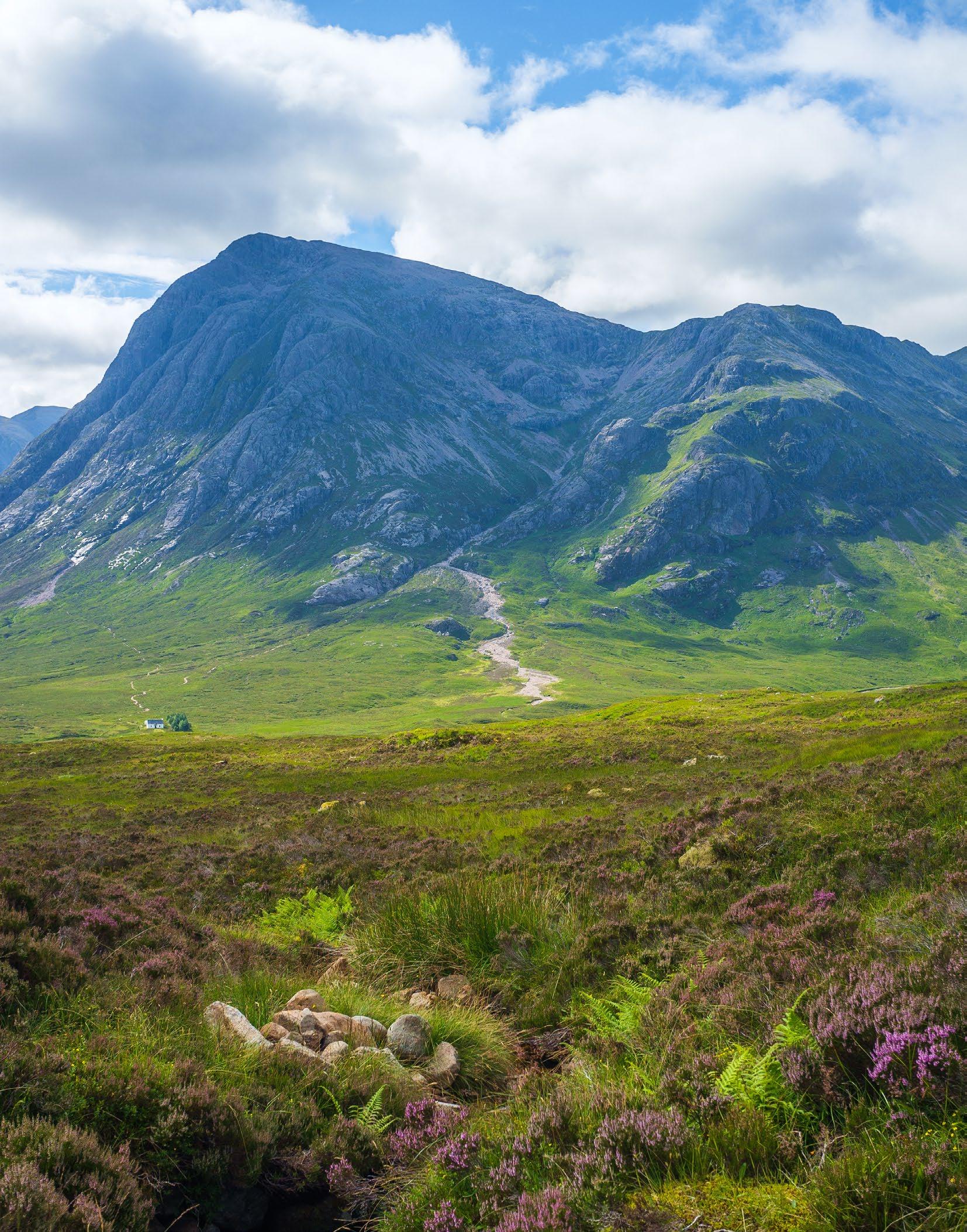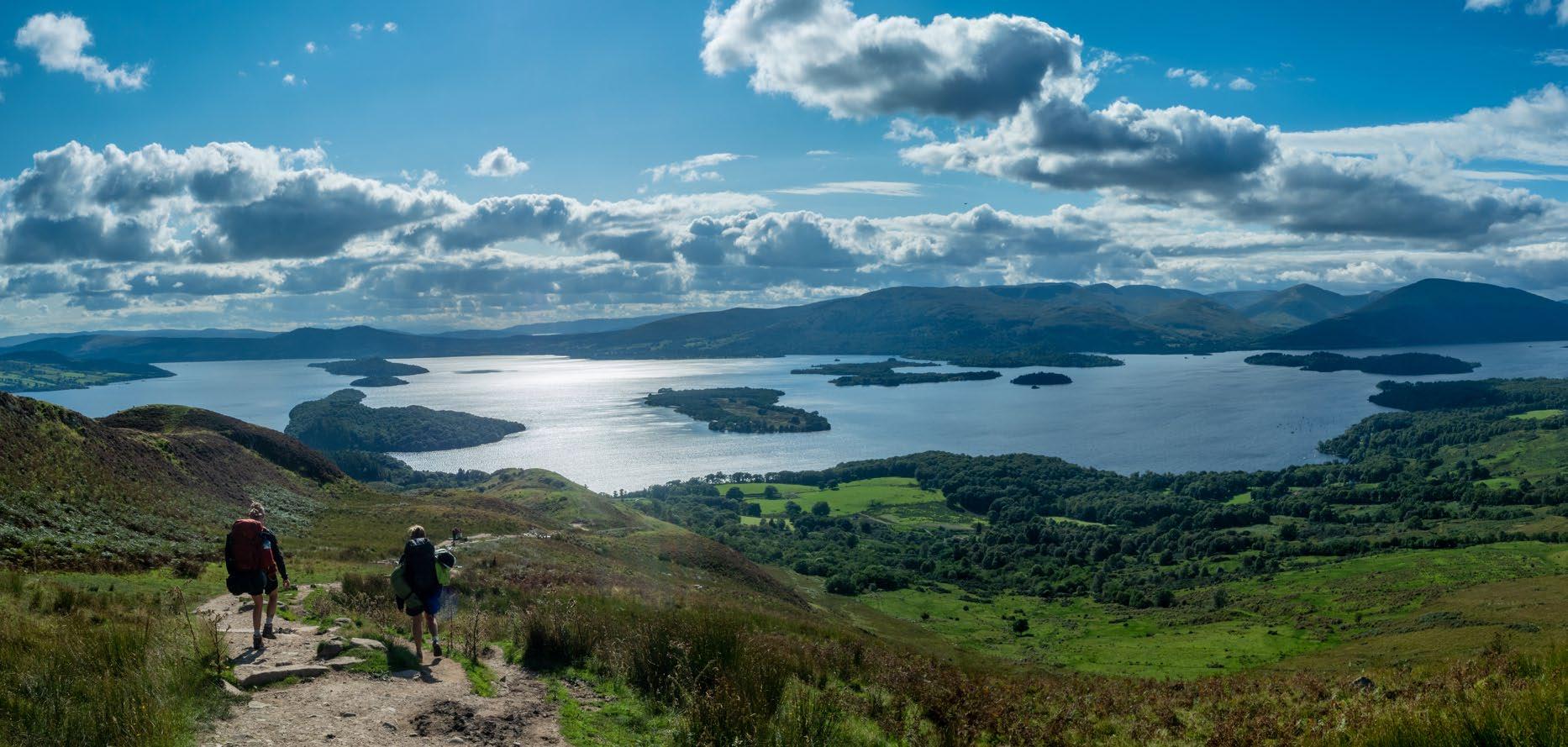
6 minute read
Walkng & Hiking
walking & Hiking
Scotland boasts some of the world’s most rewarding walking country, from short but scenic circuits, to the magnificent, challenging long distance trails. If you want your experience of the landscape to be unhurried and up close, there is no better way to do it than on foot.
Advertisement
The country is criss-crossed by walking routes (many of which are accessible to cyclists too), from the celebrated West Highland and Great Glen Ways, to island circuits such as Bute’s West Island Way and Arran’s Coastal Way. Each is remarkable in its own way, whether set apart by the views, the wildlife, the history, or a magical blend of all three.
Whether you are planning ahead, or looking for resources and landmarks as you go along, a Cicerone Guide can help you make the most of your trip.
While a reasonable level of fitness and appropriate kit are recommended for the longer walks, the most important attributes required are determination and enthusiasm – and these will be well repaid.
All of the region’s major trails are divided into stages and way-marked, and most can be taken on over several days as a complete adventure, or sampled in smaller sections. Most routes have facilities, campsites and other accommodation along the way, though it pays to book in advance, particularly at busy times of year – and (particularly on the busiest walks) consider employing a baggage carrier to transport your overnight bags.
Though some long-distance walks finish in tranquil spots, others will take you past vibrant bars or cafes where a cold drink and a warm welcome are part of the experience – if you are looking to end the day sharing hiking yarns over a pie and a pint, you’ll be able to spot the fellow walkers from the flip-flops, wind burn and blistered toes.
Take plasters, midge nets and good waterproofs (though hopefully you won’t need them) and wear a smile – many a lifelong friendship has been forged on the slippery steps of the Devil’s Staircase (West Highland Way).
walking & Hiking
HIKING
There is no better way to have an intimate encounter with the landscape than on foot. Setting your own pace means that the experience can be unhurried and up close, and better still, it’s free.
Scotland boasts some of the world’s most rewarding walking country, from short but scenic circuits, to magnificent Munros and memorable long-distance trails. The country is criss-crossed by walking routes (many of which are accessible to cyclists too), from the celebrated West Highland and Great Glen Ways, to island circuits like Bute’s West Island Way and Arran’s Coastal Way. For hill walkers, the undulating landscape offers an unrivalled choice of challenges, and for those who prefer a forest or riverside meander, there are short and scenic pathways aplenty to explore, many of which are accessible for wheelchairs and buggies.
Wherever you walk, please keep in mind your own safety and the safety and wellbeing of the countryside and its other users. Appropriate clothing and footwear is a must, as is a mobile phone. For longer walks, its a good idea to let someone know your plans.

LONG-DISTANCE TRAILS
While a reasonable level of fitness and appropriate kit are recommended for the longer walks, the most important attributes required for these are determination and enthusiasm – and these will be well repaid.
All of the region’s major trails are divided into stages and way-marked, and most can be taken on over several days as a complete adventure, or sampled in smaller sections. Most routes have facilities, campsites and other accommodation along the way, though it pays to book in advance, particularly at busy times of year – and (particularly on the busiest walks) consider employing a baggage carrier to transport your overnight bags.
Though some long-distance walks finish in tranquil spots, others will take you past vibrant bars or cafes where a cold drink and a warm welcome are part of the experience – if you are looking to end the day sharing hiking yarns over a pie and a pint, you’ll be able to spot the fellow walkers from the flip-flops, wind burn and blistered toes. Take plasters, midge repellant or midge nets and good waterproofs (though hopefully you won’t need them) and wear a smile – many a lifelong friendship has been forged on the slippery steps of the West Highland Way’s Devil’s Staircase.
FOCUS ON THE WEST HIGHLAND WAY
The 96-mile West Highland Way is Scotland’s oldest and most celebrated long-distance walking route, though it has been open in its current form for just over 30 years.
Wending its way from Milngavie, near Glasgow, northwards to the Highland town of Fort William, via Loch Lomond, Rannoch Moor and Glencoe, it is a spectacular journey that combines the contrasting highlights of Scotland’s landscape with opportunities to visit some striking out-of-the way spots.
The route is a challenge, but within the capabilities of most fairly fit adults, 30,000 of whom complete it each year, and while walkers speak warmly of the exceptional setting, it is the camaraderie that many say provides the best memories - meeting up with strangers at the start of the walk, and seven days later finishing it with friends.
“My husband and I have walked the West Highland Way three years in a row and we love it!” wrote one happy walker on a travel forum. “The scenery is amazing!”
As well as the constantly changing backdrop, there are countless places of interest along the way, from the Duntreath Castle and Glengoyne Distillery in the early phases of the walk, to Rob Roy’s cave (supposedly the outlaw’s hideout) on Loch Lomond, the ruined St Fillan’s chapel and the chilling, but informative visitor centre at Glencoe.
Every walker has a favourite part, and while some embrace the gentler, scenic paths around Loch Lomond and the tranquil view across the water from Rowardennan, others are thrilled by the first sight of Beinn Dorrain mountain just after Tyndrum, followed by the atmospheric Rannoch Moor, or relish the test of the Devil’s Staircase - the highest and most infamous point on the route.
HILL WALKING AND MUNRO BAGGING
Munro bagging has long been one of Scotland’s most popular outdoor pastimes. Locals and visitors alike relish the challenge of walking to the top of one or more of the country’s collection of Munros, the term used for mountains which are over 3,000ft (named after Hugh T Munro, who first listed them). Each walk completed is a Munro ‘bagged’ and, for some, it’s a lifetime’s challenge to get the set of 282.
You don’t have to make it to triple figures to enjoy the thrill of conquering a Munro though – there’s a tremendous sense of achievement in just one. The West Highland region is home to many of the country’s most popular Munros, including several, such as Ben Lomond and Ben Lawers, that are suitable for beginners.
If you are planning on tackling your first Munro, it’s worth doing your research and starting with one which has a clear path and public transport access/ plenty of parking near the start. The website www. walkhighlands.co.uk is an excellent resource for Munro baggers and all kinds of walkers.
JUST WALKS
Not everyone’s idea of a wonderful walk is one that results in blisters and windburn, and the West Highlands boasts many shorter walks and trails that still showcase the delights of the landscape and provide a chance to see wildlife, waterfalls and views that will take your breath away. Local knowledge is one of the best ways to find out about these, so it’s well worth asking your hosts for their recommendations.
Forestry and Land Scotland manage much of the country’s woodland on which way-marked trails follow graded paths (from easy to strenuous) so that you can pick the right forest route for you. There are maps and more information at www.forestryandland.gov. scot.
The National Trust for Scotland cares for many of the country’s most beautiful and popular destinations, including Glencoe. Its website also includes recommended walking routes and tips www.nts. org.uk










